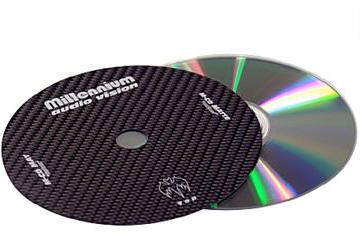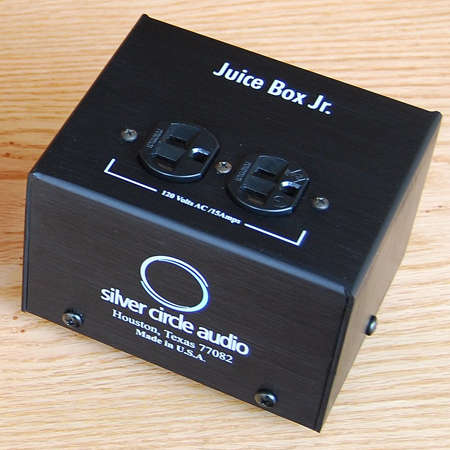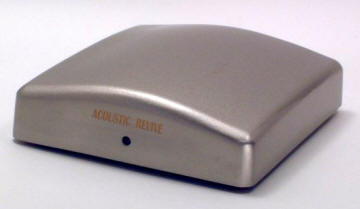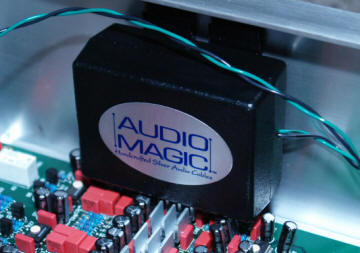You are reading the older HTML site
Positive Feedback ISSUE
september/october 2008
Recession Tweaks: Five tweaks for under $500
by Ryan Coleman

I would be happy to debate the validity of the statistics that show that the US economy is still experiencing above-zero growth; it is careful machinations of import prices and some slight of hand fudgery that shows the US skirting recession at this time (though I'd bet dollars for donuts you'll see a formal definition of one between Q3 2008 and 2009). Inflation is painfully high and jobs are tougher to come by. But, regardless of what the bureaucrats say, we're in a consumer-driven recession. People feel it. Times are tough.
This makes for tough times in the audio business (along with every other business). Reports of some long-tenured manufacturers going under (Thor and Graaf to name just two) potentially hints at what might happen to other firms. High-end buyers are retrenching. But what about the audiophile who regularly budgets money for upgrading their system and doesn't want to commit too much money during times like these? Ladies and gentlemen, bring in the tweaks!
I'm an avowed tweaker; room treatments, AC filtration, capacitor upgrades, isolation platforms---you name it, I'll try it, as I'm a believer. I've seen, er, heard the influence of proper setup and attention to detail (in other words, tweaking) in making modest systems good, and good systems great. The absence of the attention to detail will, like putting cheap gas in a sports car, keep it from performing to the levels it is truly capable of.
So, in the spirit of the day, I present 5 tweaks that won't break the bank. Some I can recommend unconditionally, some with caveats. Anyone who's looking to make incremental improvements in their rig would be well served by auditioning some of these fine products.

Millenium Audio Video Carbon CD Matte
MSRP $119
I've tried a few CD mats in the past and while I've found subtle improvements, I was never sold on them. In retrospect, I realize that the reason for that was twofold: 1) a CD mat is not going to do much of anything unless the rest of your system is finely tuned to begin with, and 2) none of the other CD mats worked as well as the Carbon CD Matte from Millenium.
You cannot find an easier tweak to install than a CD mat; it's a simple process of placing it on top of the CD before loading it into the player (be sure to center it) and going from there. The Carbon CD Matte is far thinner than one thinks when looking in the package, so it should slide onto anything without issue, but in the interests of full disclosure I did not have the liberty to try it in some of the top loading players or those with clamping-type transports, so caveat emptor.
The biggest nit to pick about my EMM Labs CDSA is the transport; I've openly wondered if an upgraded transport would take the unit even further towards the edge of the art (and yes, I'm using the upgraded transport). The Carbon CD Matte helps address micro-vibrations of the rotating disc, which results in a few noticeable improvements in my system. As with any successful effort to remove vibrations in a stereo system, fine details were more distinct and apparent, with less blurring and obscuration. Tambourines were a great example of this phenomenon; individual bells rang, rather than a hodgepodge of ringing bells. Also, I noticed improved tonal complexity, as the Carbon CD Matte was effective in subduing some of the 'digititis' glare that all CDs seem infected with. Harmonics were slightly more fleshed out, and upper treble was not as whitewashed. Finally, and most audibly, I heard improved stage depth whenever the Carbon CD Mat was in place. CDs are typically terrible in conveying the 'air' that LPs have as a birthright, but the Carbon CD Matte helped reduce the disadvantage by making the soundstage less flat and 2-dimensional.
Can the Carbon CD Matte turn a sow's ear of a CD player into a silk purse? Nope; products like these are designed for ambitious systems that have already addressed obvious areas of power conditioning, vibration control, room tuning, and cabling. But if you have done these things and you want to try to get another 5 to 10% out of your existing CD player, the Carbon CD Matte might be just your ticket.

Silver Circle Audio Juice Box Jr.
MSRP $199
It's not often you can find a power conditioner that works for amplifiers. The trouble is that active power conditioners (those which use some sort of isolation transformer) invariably limit available power to the amps to that which can be stored inside the conditioner. Given this, you're left with two choices: get an active power conditioner with a monster of a transformer inside (like the Silver Circle PP1 5.0 which uses a 5.0kVa tranny) or go with passive conditioners. My favorite conditioner, passive or active, is the Acoustic Revive RTP-4. While it is passive and thus ideal for amps, it also costs as much as some amps. So, what's an audiophile on a budget to do?
For a mere $199, Silver Circle has the Juice box Jr., a passive power conditioner that entails a small (5"x4"x4") box with a Furutech outlet, an IEC inlet, and some proprietary conditioning elements inside. Putting my amps on it, there was (thank goodness) no dynamic compression and all of the good things that a power conditioner does—such as quieter backgrounds and less grit in the treble—the Juice Box Jr. delivered. The same impressions held true for source gear; music was simply more enjoyable with the Juice Box Jr. than when listening without any conditioning.
While I wish I could say that it competes with my RTP-4, it does not. The RTP-4 has a sweeter treble, has more low level detail, and a stone dead black background. Then again, the RTP-4 is over 10 times more expensive. Hell, the outlets in the RTP-4 cost more than a complete Juice Box Jr., and I suspect the Juice Box Jr. would sound quite a bit better with some of those high dollar Oyaide or Furutech outlets inside. But then the price goes up and the Juice Box Jr. becomes something other than what it is: a bargain in AC conditioning for those audiophiles who have more pressing uses for their hard earned money. Anyone who has their rig plugged into just any old AC outlet need start here, as for very little cash, you'll understand.

Acoustic Revive RGC-24
MSRP $425
I've plenty of experience with Acoustic Revive products, having already recommended their DSIX digital cable, and raved (and bought) their RTP-4 AC conditioner with accompanying Power Reference AC cable (and I'll touch on the RR-77 later in this piece). The RGC-24 piqued my interest through some local audiophiles who were raving about it. Furthermore, I'm still new to PFO and, while Dave Clark has already reviewed this product, I didn't yet know if he were crazy and deaf or if he actually has a good set of ears. (Sorry Dave, but really, I know I can hear, but everyone else? Who knows—they might be deaf idiots! Now as for Dave, well, yes, Dave can definitely hear, so listen to his opinions. How can I say this? Well, I agree with Dave's review, that's why. Which by extension means you should listen to my opinions to, ok?)
Based on his review of the RGC-24 (a very thorough piece I'd direct you to at https://positive-feedback.com/Issue34/noise.htm), I can again reiterate that Dave does have a good set of ears—his review is spot on. The RGC-24 is a terrific product in select applications, working wonders to remove the 3 "G"s that we audiophiles battle constantly: Grit, Glare, and Grain. How it works its magic is beyond me; the esoteric design and incomprehensible functioning seems to be a common trait of the Acoustic Revive products. What I can say is that for one to fully appreciate it, you need to hook it up to your source, leave it for an hour (or longer), and then remove it. But have your checkbook handy.
The RGC-24 reminds me of AC conditioning; you don't know how important it is until you try to listen without it. The RGC-24 has the same type of benefit; removing a distortion that is manifest in a sharp ringing from the upper mids on throughout the treble range. Hooked up to my EMM Labs CDSA, I found that I could listen longer, and louder, as a layer of grain that I never knew existed is wiped away. There's more air (thanks to the removal of this noise) resulting in a more well-defined soundstage with better depth. This noise removal also results in the treble having a sweeter decay. This product is an antidote to the stereotypical "bad digital" sound that keeps some stubborn audiophiles as pure Vinylphiles.
However, this strikes me as a product where more is not necessarily better. When your system's top end is balanced and you're satisfied, adding another RGC-24 is the wrong thing to do as you'll move from "added benefit" into perceived "sins of commission" where some treble decay is lost. In my experimentation, I've found that the further from the source you go, the more you have the potential to over-treat the system, resulting in deleterious the effects on the treble. Start with the source. Always.
In my experimentation, I've consistently found this great truth in audio: make every effort you can to remove as much noise as possible from the source, but be less aggressive in your efforts the further you go from the source. So, while I'd recommend using AC conditioning, the RGC-24 and the Audio Magic Pulse Gen (more on this product later) on the source, I'd forego the tweaks and simply use AC conditioning on the preamp. I'd also recommend that amps use either passive AC conditioning or simply go straight into the wall (using an audiophile-approved outlet with dedicated AC wiring to it of course). Naturally, your experiences may vary, but this is sound advice for those who are lost in the forest at the moment.
In sum, the RGC-24 is a keeper, and highly recommended for all digital gear.

Acoustic Revive RR-77
MSRP $425
Ok, this thing takes the official Ryan Coleman award for "oddest tweak that works." As you've likely read by now, the RR-77 is a Schumann frequency resonator that puts out an ultra-low 7.83hz frequency. It doesn't look like much, and when you take it out of the box, it doesn't feel like much either. Operation couldn't be much easier; simply put it in your listening room, try to keep it elevated (ideally) between your speakers, and turn it on.
I've tried it in a few different systems and invariably the RR-77 had a clearly audible effect on the bass region. Much like bass traps or room tuning devices, the RR-77 reduced bass boom and left the music more tuneful and articulate—think sealed subwoofers vs. ported and you'll have an idea of what I'm talking about. This improved articulation in the bass resulted in better venue definition; the corners of the recording venue are easier to pick up. And much like room treatments, I found that the reductions in bass boom and overhang resulted in improved midrange articulation as those pesky bass nodes were no longer infecting the rest of the spectrum. Kudos to the RR-77. And again, much like room treatments, I also found stage depth improved with clearer space between performers whenever the RR-77 was in use.
This seems outrageous for a passive device that's not even plugged in to the system. Well, dear reader, you don't know the half of it. I also found the unit energizing—as in I was physically more energetic, but it wasn't all welcome (particularly as I'm high strung to begin with). I found myself noting a very slight physical pulsation in my chest cavity; not a pain mind you, but something that wasn't there before. This was quite stimulating physically, though my wife noticed nothing and thought me crazy/crazier for sensing this. This may be an issue for you or not. I'm just pointing out all I know for those who are interested.
I've now reviewed four Acoustic Revive products; I wrote in my first review that this company was going to be one to watch for, and every Acoustic Revive product I've auditioned subsequently has only reinforced that belief. The RGC-24, like every other Acoustic Revive product, clearly improved the sound of my system and is definitely worthy of an audition.

Audio Magic Pulse Gen ZX
MSRP $400
The Audio Magic Pulse Gen ZX is simple to install across the hot and neutral terminals of the component's IEC, but its size may make for some troubles; some components don't have the 2" by 2" of spare real-estate inside. That's too bad as this is a product that simply must be tried inside digital sources.
I'd have to say that no product ever flummoxed me more nor made me question what I was hearing than this one. It seemed I was hearing more and less at the same time.
This product concentrated its impact on the midrange and treble areas. While it seemed the treble range was shelved down by a couple of decibels, I was confident that more information was coming through at the same time: piano decays, horns, guitars, cymbals, bells—you name it. The higher in the frequency balance, the more consistently it sounded a little quieter in the mix versus the rest of the frequency spectrum, but with more information being resolved.
However, I did say that it also impacted the midrange and here (much like the treble range) it was also delivering more information …lots more. Vocals especially were revelatory; part of the failure of home stereos is their inability to capture all the minute harmonic fluctuations that occur in sound (recorded or not). Nowhere are we more sensitive to this than with vocals, as we're constantly listening and talking (unlike music, which few of us are involved in on a daily basis). The Pulse Gen ZX resolved those gentle harmonic fluctuations; the pitch inflections that take a person from ideal overly homogenized recorded voice back to being a human that was recorded and thus making the vocal reproduction more lifelike.
Here's another head scratcher. I was consistently able to listen at a louder volume with the Pulse Gen ZX in the rig than without. As for why, I point to my findings on the treble region. It's not the bass frequencies that lead to listener fatigue; just think about those goofy bass-boom car stereos that people drive for hours with. It's the treble that causes fatigue, and with the treble slightly attenuated (but while resolving additional information), I found myself listening louder and with less fatigue which meant more involvement with the music.
At this point I had to question all I knew. It is inherently contradictory to hear more information within a frequency range that's attenuated at the same time. But I think I came to a theory that explains it. The Pulse Gen ZX is designed to eliminate self-generated noise within a component. It seems to me that self generated noise (EMI/RFI) manifests itself as a distortion—a glare in the treble range that the ear can perceive (as we're sensitive to this frequency range, per my earlier comment on listener fatigue); one that we're so used to hearing that we simply assume its correct. By removing it we're actually forced to reevaluate all our prior conceptions of recorded music in this frequency range. Much like your first pair of eye glasses, your standard of what is accurate will change.
Another analogy from photography: when a photo has a flash that is too aggressive or uneven, the central part of the face will be too bright (the nose protrudes and is thus closer to the flash) and the neck and perimeter of the face which are further from the flash will appear noticeably darker. The contrast in shadings between the two areas of the face is obviously wrong. That sums up digital without the Pulse Gen ZX. The insertion of the Pulse Gen ZX is like getting a good flash where all areas of the face are more consistently lighted. It's more lifelike and more pleasing to look at. It's just better.
The insertion of the Pulse Gen ZX results in what one initially thinks is treble attenuation, but is actually the removal of a pervasive distortion that we've been living with since digital was forced upon us. The retrieval of more information throughout the treble and midrange is evidence that this distortion, which previously masked information encoded on the disc, is removed. So many CDs are poorly mastered and too hot on top, that the Pulse Gen ZX was an unmitigated improvement on them. On a few CDs (maybe 10% of those I own) I found it a trade-off between the reduced treble emphasis which sounded a bit too soft in the mix versus the benefit of the additional inner detail that the Pulse Gen ZX consistently delivered upon. But given its benefit on 90%+ of CDs and the promise of more inner detail off of every CD, that's a tradeoff every audiophile should be willing to make. One of my friends summed it up when he said "it sounds more analogue." Indeed it does. If digital SOUNDS LIKE THIS (don'tcha hate people shouting in text?), the Pulse Gen ZX says "go ahead, turn it up, I won't bite."
(I had every intention of trying this product in my preamp and amps, but my preamp didn't have space, and after loaning out a few Pulse Gen ZXs for insertion into some very expensive Esoteric digital gear, I found all I got back was a promise that the owners would pay for them. However, I suspect that its benefit, much like the Acoustic Revive RGC-24, will be most audible and beneficial in the source, and its effects downstream will grow increasingly questionable. However, that's just a hunch; Jerry, care to send a few more?)
What can I say? Highly recommended for any digital component you are using. If you're using digital amps, do try this thing and drop me a line.
